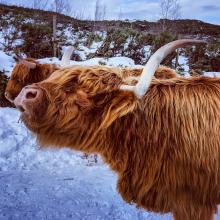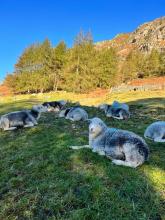Data driven or digital farming has huge transformative potential to enable a sustainable agriculture. It aims to integrate machine enhanced information streams across a range of spatio-temporal scales, with advances in computational tools and scientific understanding, to optimise real time management of agro-eco systems. However, much work needs to be done to realise its potential.
Here we describe the Scottish Government RESAS funded project, Sustainable Agricultural Tools, that is developing bioinformatics, modelling and statistical methods, tools and approaches to support the transformation of such data streams into information that can drive forward sustainable agriculture. Ongoing research is developing new tools to assess freedom from infection, estimate disease risks and make better use of both molecular data and automatically collected electronic sensor data to enhance monitoring and management of agricultural systems. Consistent with the Scottish Government's commitment to Open Science we place openness, transparency and research integrity at the heart of our work.
Statistical Genetics and Bioinformatics
1. Meta analytical approaches to mining of 'omics databases
Developing meta-analytical approaches to find variables that give consistent signals across a range of experiments investigating the same (or at least similar) research questions. From a statistical perspective, this constitutes a meta analysis across thousands of variables (e.g. genes).
2. Environmental data: k-mer and combined k-mer /genomic approaches

Variants of k-mer analysis, for instance the KPop method we recently developed enables expression of sample contents in terms of a vector of k-mer fractional abundancies, i.e. compositional data, which can then be analysed in terms of methods such as Correspondence Analysis. Statistical methods are being developed to connect k-mer based analysis with other sources of information, for instance metadata (here a set of discrete or continuous variables) or taxonomic/genomic information if available.
3. Animal health and protection from disease: tools for genome reannotation
Developing tools for easy reannotation of viral and bacterial pathogens: (i) software to process a relatively large number of samples non-interactively; (ii) GUI interactive tools to facilitate manual analysis and annotation of automatically generated sequences; (iii) genomic annotations presented as databases accessible from GUI based tools. The GUI tools will leverage the VBRC tools codebase, for interactive exploration and annotation of short genomes, which is now maintained by BioSS .
Modelling and Statistical Tools for Plant and Animal Production

1. Modelling and inference for disease dynamics
Using analytic and simulation-based approaches we are developing methodology for modelling and inference of disease dynamics from available data, understanding persistence of AMR, and integrating observational and diagnostic test data with expert opinion to evidence freedom from infection. Building on existing strengths in data augmentation and Sequential Monte Carlo, state-of-the-art Bayesian methods are being developed for disease dynamics, enabling quantitative risk assessment and evaluation of control options.
2. Statistical methods for high resolution automatically collected data
Flexible methods are being developed for using automated sensor data to detect changes in real time that may correspond to adverse events, and thus provide “early warning” systems that could be used to trigger further investigation.
3. Modelling behaviour
We are developing tools including agent-based models to better characterise the behaviour of key actors to enable understanding of their interaction with epidemiological, ecological, agricultural, and social system dynamics. Examples include: farmer decision making in dealing with pest and disease risk and control; consumer food choices; and the interplay between land management and ecological response at a range of timescales.
BioSS contact

Claus Mayer
This work is in collaboration with SEFARI, The James Hutton Institute, The Moredun Institute, Royal Botanic Garden Edinburgh, The Rowett Institute, and Scotland's Rural College.
Scottish Government’s Rural and Environment Science and Analytical Services Division RESAS (BioSS-2-SAT)
